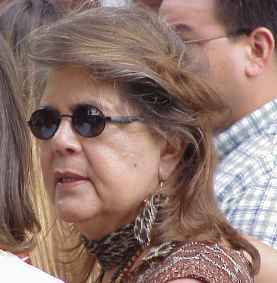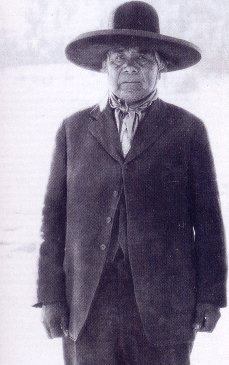Osceola
Chief: Osceola (aka Billy Powell)
Born: 1804 in Maskókî or Creek village of Talisi, now known as Tallassee, Alabama near present day Tuskegee AL
Died: January 30 1838, Fort Moultrie, South Carolina
Nationality: Creek (also Scots-Irish and English)
Osceola (/ˌɒsiːˈoʊlə/ or /ˌoʊseɪˈoʊlə/). This is an anglicized form of the Creek Asi-yahola (pronounced [asːi jahoːla]); the combination of asi, the ceremonial black drink made from the yaupon holly, and yahola, meaning "shout" or "shouter".
Osceola was an influential Florida Seminole leader. For almost two years, he led a band of warriors in resistance against the United States during the second Seminole war. He was born Billy Powell, in Maskókî or Creek village of Talisi, now known as Tallassee, Alabama. He was the son of Polly Copinger (Tallassee woman) and William Powell (English trader). He was raised in Creek traditions. When Billy was born, many of the people in his village were of mixed blood Indian/English/Scottish with some African blood thrown in for good measure. The Creek nation had lived along the Tallapoosa River in present day Alabama for generations. In 1814, after the Red Stick Creek were defeated by US forces, Polly migrated to Florida along with other Creek refugees and joined the Seminole where Billy grew to adulthood and was given the name Osceola.
European-American settlers pressured the United States government to remove the Seminole from Florida, especially after the US had acquired Florida from Spain. The further encroachment from settlers led to many skirmishes between Seminoles and the military. Lands were seized and the Seminoles moved farther south into Florida. Additional pressure was laid upon the Seminoles to agree to sell their land and move to lands west of the Mississippi. In 1832, the Treaty of Payne’s Landing was signed by a few chiefs, but others do not agree to the removal. In 1835, Osceola and his warriors murdered an Indian agent who had locked him up. For the next two years, Osceola led a successful resistance which is regarded as the second Seminole War. He was captured in October 1837, when he went for peace talks. The deceit involved in his capture led to a nationwide uproar. Apparently, very ill at the time of his capture, Osceola died in prison on January 30, 1838.
Resources about Osceola:
Osceola. (n.d.) In Wikipedia. Retrieved January 27, 2017 from Wikipedia.
Wickman, Patricia R. Osceola’s Legacy. (Fire Ant Books). N.p.:U of Alabama, 2006.
Hatch, Thom. Osceola and the Great Seminole War: A Struggle for Justice and Freedom. New York: St. Martin’s, 2012

Wilma Mankiller

Wovoka

